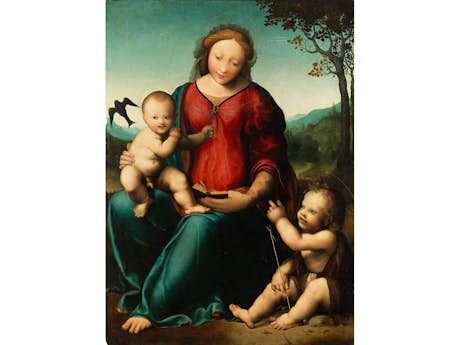Your search for Pietro di Cosimo in the auction
Old Master Paintings - Part I
Thursday, 21 March 2024
» reset
Your personal art agent

You are interested in works by Pietro di Cosimo?
We are happy to inform you, if works by Pietro di Cosimo are to be auctioned in one of our upcoming auctions.
Please accept our privacy policy
181
Piero di Cosimo,
1432 Florenz – 1521, zug.
MADONNA MIT DER SCHWALBEÖl auf Holz.
87 x 63 cm.
Verso zwei Festigungs-Querleisten.
Catalogue price € 120.000 - 180.000
Catalogue price€ 120.000 - 180.000
$ 129,600 - 194,400
£ 108,000 - 162,000
元 938,400 - 1,407,600
₽ 11,938,800 - 17,908,200
Wenngleich das Gemälde in der Gesamtauffassung sofort an die Nachfolge Raffaels denken lässt, und wenn auch der Kreis um Girolamo di Benvenuto da Siena ins Gespräch gebracht wurde, so lassen Detailbeobachtungen entschieden mehr an Piero di Cosimo denken. Im Gegensatz zu fast allen Madonnenmalern, die dem Gesicht der Maria eher nachdenklichen Ernst gegeben haben, ist in den Marienthemen des Piero weit häufiger, um nicht zu sagen geradezu einzig bei ihm, ein zufriedenes Lächeln zu sehen, wie dies auch hier im Bild der Fall ist. Gezeigt ist die traditionelle Dreiheit von Maria mit dem Jesuskind und dem Johannesknaben. Zum Optimismus, den der Maler dem Bild zu vermitteln beabsichtigt hat, zählt auch die Zutat der Schwalbe, die von Jesus an einen feinen Faden gehalten wird, ist dies doch das Symbol für die Auferstehung und das ewige Leben. Dem entspricht auch das Lächeln, mit dem das Jesuskind dem Betrachter entgegenblickt. Dagegen hält der Johannesknabe das dem Leben Jesu bevorstehende Kreuz, hier aus dünnen Stängeln gestaltet. Auffallend ist hier neben diesen Detailbeobachtungen auch die betonte Feinheit beim Faden des Vogels, wie ebenso beim Kreuz des Johannes. Ein Gestaltungscharakter, der womöglich noch gezielter auf einen bestimmten, noch nicht eruierten Meister verweisen könnte. Im leicht zum Büchlein herabgeneigten Kopf der Maria wird erkennbar, dass sich der Maler mit der perspektivischen Verkürzung auseinandergesetzt hat. Farbkompositionell korrespondiert das markant ins Bild gebrachte Schwarz der Schwalbe zu der betont schmalen Borte am roten Kleid, sowie dem Einband des Gebetbuches in der Hand. Ein solcher Farbkontrast ist auch in seinem gleichthematischen Bild von 1505/10 zu beobachten. Der landschaftliche Hintergrund, der eine Talmulde zeigt, ist – gegenüber den Raffaelmadonnen – ein etwas späterer Bildgedanke, der bereits einen Einfluss von Leonardo erkennen lässt. Dies stimmt auch mit dem überein, was wir über Piero di Cosimo und dessen malerische Entwicklung bereits wissen. A.R.
Literatur:
Vgl. Mina Bacci, Piero di Cosimo, Mailand 1966.
Vgl. Anna Forlani Tempesti, Elena Capretti, Piero di Cosimo. Catalogo completo. Florenz 1996.
Vgl. Alexander Rauch, in: Rolf Toman (Hrsg.), Die Kunst der italienischen Renaissance, Teil Malerei, Köln 1994. (1392021) (11)
Piero di Cosimo,
1432 Florence – 1521, attributed
THE VIRGIN AND CHRIST CHILD WITH A SWALLOW
Oil on panel.
87 x 63 cm.
Two parquetting slats on the reverse.
Although the overall design of the painting immediately suggests a successor of Raphael, and although the circle around Girolamo di Benvenuto da Siena has been considered, details rather point towards Piero di Cosimo. In contrast to almost all Madonna painters, who gave the Virgin’s face a more thoughtful, serious expression, Piero’s Virgins are often, maybe uniquely, depicted with a contented smile as is also the case in the present painting. The composition shows the traditional trinity of The Virgin Mary with the Christ Child and the Infant Saint John. Adding to the optimism which the painter intended to convey is the depiction of a swallow, held by the Christ Child on a fine thread, as a symbol of the resurrection and eternal life. This also corresponds to the Christ Child’s smile directed at the viewer. In contrast, the Infant Saint John is holding the cross, here made of thin stalks, which foreshadows the death of Christ. Striking details are also the extreme fineness of the bird’s thread as well as the cross held by John. Compared to the Madonna depictions by Raphael, the landscape background showing a valley is a later pictorial idea that already shows the influence by Leonardo.
This object has been individually compared to the information in the Art Loss Register data bank and is not registered there as stolen or missing.
Your personal art agent
You would like to be informed of upcoming auctions if a work by Pietro di Cosimo is offered? Activate your personal art agent here.
Please accept our privacy policy
You would like to purchase a work by Pietro di Cosimo?
Your personal art agent Purchase in Private Sale Calendar
Our experts are happy to support you personally in your search for art objects.
You would like to sell a work by Pietro di Cosimo?
Consign now Private Sale Service FAQ
Your consignments are always welcome.
Our staff will be happy to personally assist you every step of the way. We look forward to your call.
Get in touch with our experts
further catalogues Furniture & Interior, Clocks | Sculpture & Works of Art | Old Master Paintings - Part I | Old Master Paintings - Part II | Impressionists & Modern Art | 19th/20th Century Paintings | Living: Saurian & Fossils | Living: Jewellery, Accessories & Wristwatches | Living: Modern Art for Young Collectors | Living: Old Master Paintings | Living: 19th/20th Century Paintings | Living: Furniture, Interior, Sculpture, Works of Art, Miscellaneous | Living: Park Decoration
















